India is a country in southern Asia that ranks as the largest country in the world in population. India is also one of the most densely populated countries in the world and one of the largest in area. Its capital is New Delhi. Mumbai, formerly called Bombay, is its largest city.
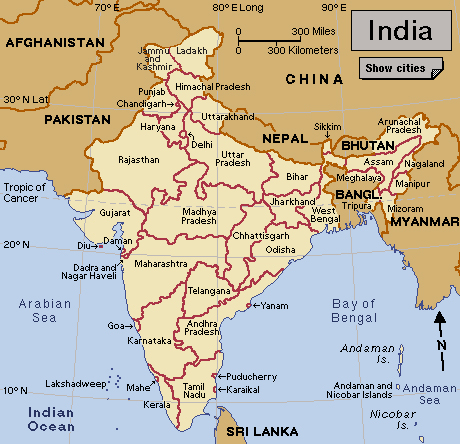
Much of India forms a peninsula that extends southward into the Indian Ocean. India is bordered on the west by the Arabian Sea and Pakistan; on the north by China, Nepal, and Bhutan; and on the east by Myanmar, Bangladesh, and the Bay of Bengal. India, Bangladesh, Bhutan, Nepal, and Pakistan are sometimes said to make up a region called the Indian subcontinent.
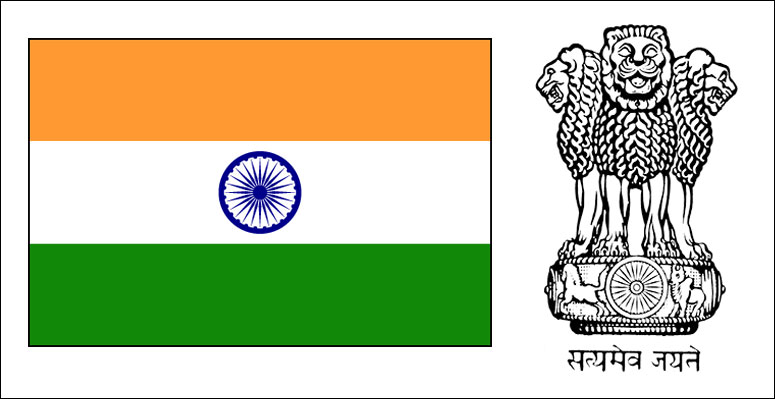
India is a land of great variety and contrast. The mighty snow-capped Himalaya, the world’s tallest mountain system, rises along its northern border. A vast, scorching desert lies in the west, but parts of eastern India receive some of the highest rainfall in the world. The country also has broad plains, winding rivers, lush rain forests, and tropical lowlands.
The people of India belong to a variety of ethnic groups and speak hundreds of dialects and languages. Hindi is the national language and is widely spoken in north and central India.
The people of India practice a number of religions. A large majority are Hindus, but India has one of the largest populations of Muslims in the world as well.
Indians vary widely in terms of education and wealth. India has a growing number of scientists and engineers, but about a fourth of the population cannot read and write. India is one of the world’s major manufacturing countries, but many of its people live in extreme poverty.
Many Indians are farmers, and they depend on seasonal rains to grow their crops. These farmers live in villages throughout the land. On the other hand, a growing number of Indians work in offices and factories in the country’s cities. The urban centers of Delhi, Kolkata, and Mumbai are among the largest in the world. 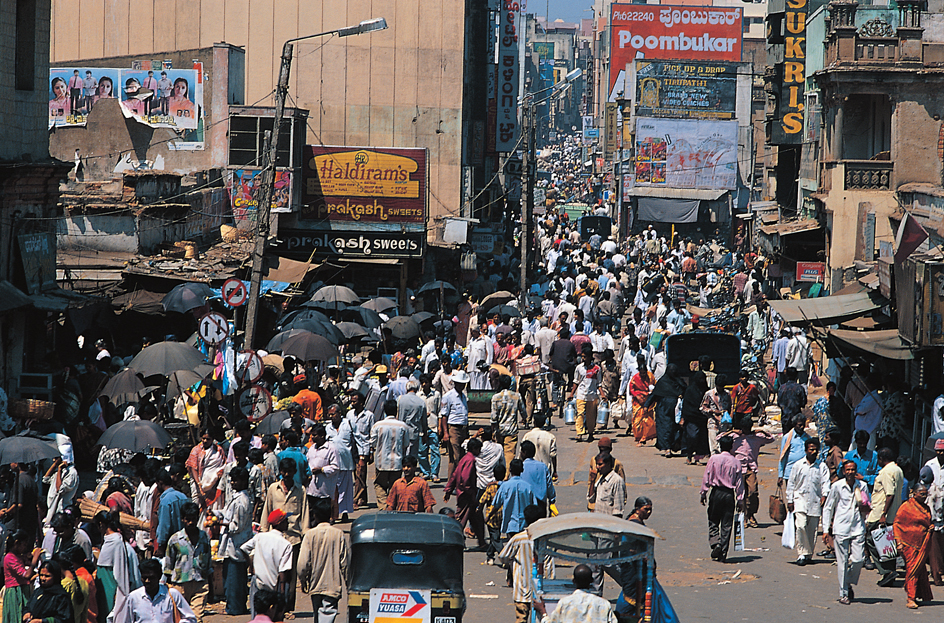
India has been home to several major empires and civilizations through the ages. The first of these civilizations, the Indus Valley civilization, was established about 4,600 years ago. Through the centuries, travelers to India described it as a land rich in gold, spices, textiles, and other valuables, and India became fabled for its wealth. Eventually, it attracted European traders, and in the late 1700’s, India came under British rule. In 1947, after a long struggle for freedom, India became independent.
People
Ancestry.
India’s people belong to a variety of ethnic groups. The two largest groups are the Dravidians and the Indo-Aryans. Most Dravidians live in the south. Most Indo-Aryans live in the north.
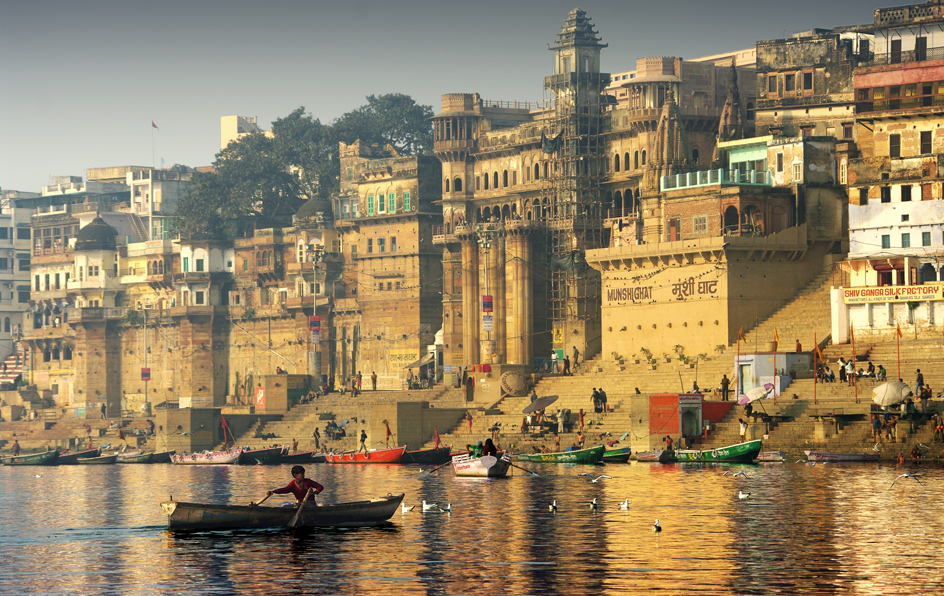
The origins of the Dravidians are unknown. Scholars believe they lived in India, growing crops and living in towns, before the ancestors of the Indo-Aryans arrived. The Indo-Aryans trace their ancestry to a central Asian people called the Aryans. Around 1500 B.C., the Aryans invaded India. They gradually conquered the Dravidians and drove some of them south.
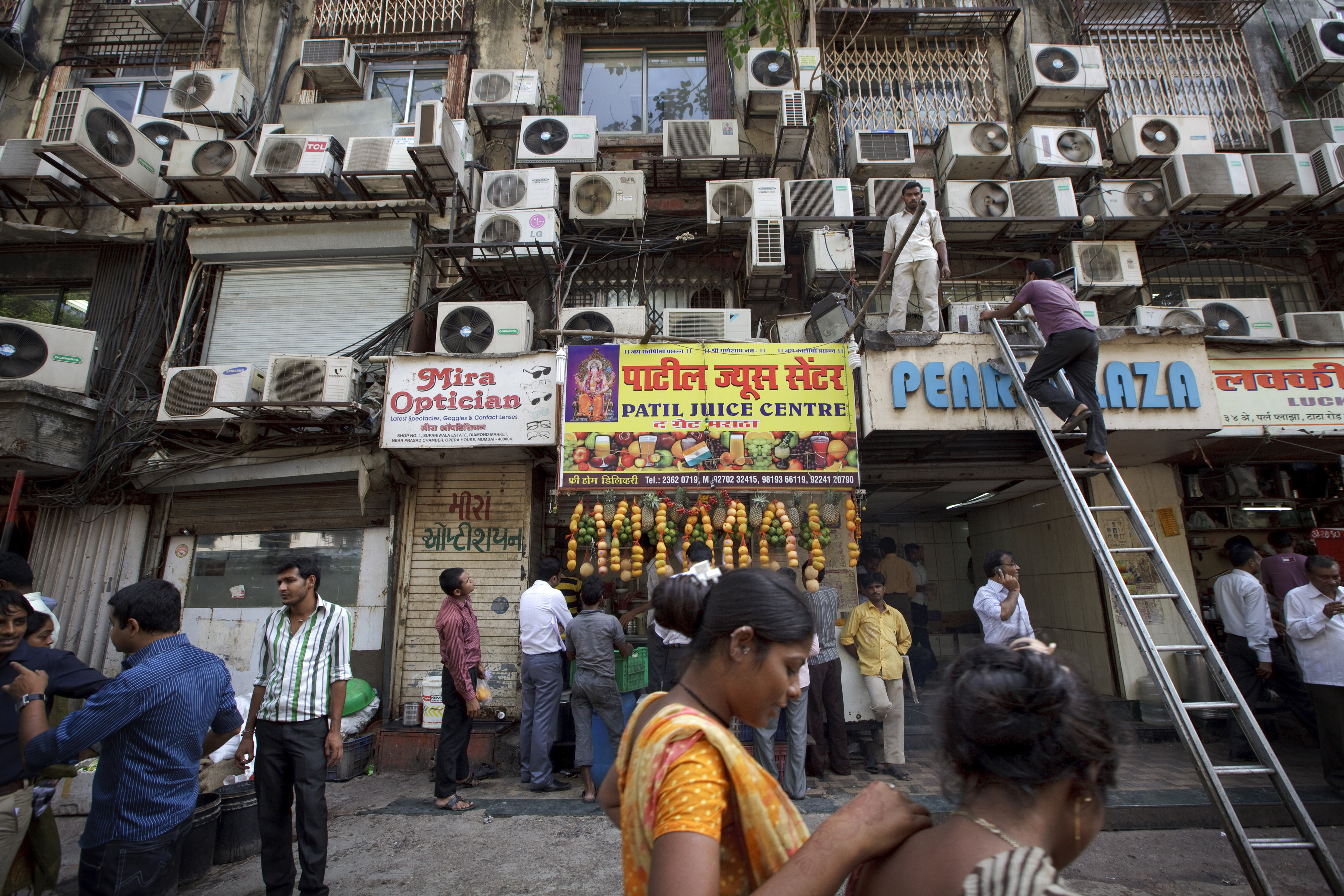
From about the A.D. 400’s to the late 1400’s, central Asian peoples settled in northern India. Many of their descendants live in the area now occupied by Bihar, Jammu and Kashmir, Ladakh, Uttarakhand, and Uttar Pradesh. Some groups who live in the far north and northeast are closely related to peoples of East and Southeast Asia.
A number of smaller groups of peoples live in remote forests and hills throughout India. Often referred to as tribes or tribal groups, these peoples include the Bhils, Gonds, Khasis, Mizos, Mundas, Oraons, and Santals.
Languages.
People in India speak over 1,000 languages and dialects—more than in any other part of the world. Most Indian languages belong to two main language groups: Indo-Aryan, which is a branch of the Indo-European family of languages, and Dravidian.
Modern Indo-Aryan languages are based on an ancient language called Sanskrit. About three-fourths of the Indian population, mainly in north and central India, speak one or more of the main Indo-Aryan languages. These languages include Assamese, Bengali, Gujarati, Hindi, Kashmiri, Marathi, Odia, Punjabi, and Sindhi.
The four principal languages of southern India—Kannada, Malayalam, Tamil, and Telugu—belong to the Dravidian family of languages. About a fifth of the population speaks these languages.
In the Himalayan region of the northeast and along the border with Myanmar many people speak Kuki, Manipuri, Naga, and other Sino-Tibetan languages. Some groups in the northeast and certain central areas use Mundari and Santali, which belong to the Mon-Khmer, or Austro-Asiatic, family of languages.
India’s national language is Hindi, one of the Indo-Aryan languages. More than two-fifths of the people speak one or more of the dialects of this language, and at least some Hindi is understood by as many as two-thirds of the population. The study of Hindi is required in elementary and secondary schools in India.
English has an official status as an associate national language. It is the common language among educated people across India, and much of the nation’s official business is conducted in English. In cities especially, many parents try to send their children to English-language elementary and secondary schools. English is widely used at colleges and universities.

Through the years, the Indian government has at times sought to introduce Hindi in non-Hindi speaking areas. Immediately after independence, the Indian government argued that national unity would be best promoted by encouraging the spread of Hindi, the most widely spoken Indian language. But non-Hindi speakers feared that they would face discrimination in their search for jobs. They also wanted recognition for their own languages. They urged that Indian states be reorganized according to language groups. After much pressure on the Indian government, the first of such states, Andhra (now the states of Andhra Pradesh and Telangana), was established for Telugu speakers in 1953.
Today, the boundaries of India’s states are based largely on language. But each state still includes people from multiple language and dialect groups. Several states have large numbers of Hindi speakers. Each state also has its own official language. For example, Bengal’s official language is Bengali and Tamil Nadu’s is Tamil.
Way of life
India is such a large and varied country that there is no one way of life practiced by all—or even most—Indians. Food and clothing vary throughout the country. People follow a number of religious beliefs and practices. Social structure differs from place to place. Nevertheless, there are some features of Indian life that are common among most people throughout the country.
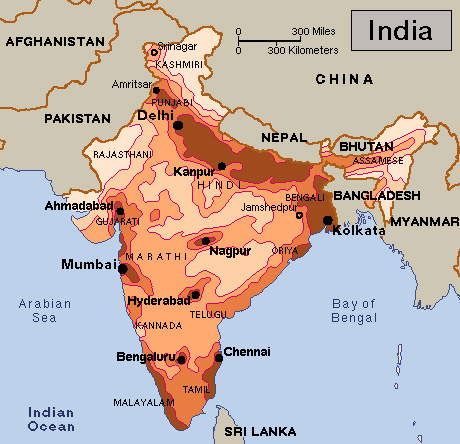
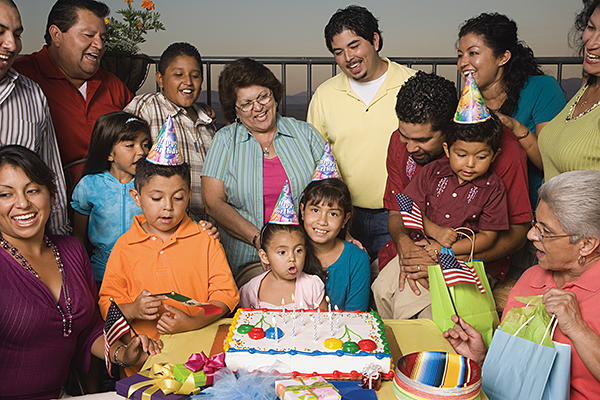
Family life.
Family ties are important to most Indians. The number of nuclear families—that is, households that consist of only parents and their children—is increasing, especially in cities. However, many families continue to live as traditional extended families. In a typical Indian extended family, three generations live together in one household. Upon marriage, a woman leaves her parents’ home and shares a household with her husband and his relatives, including his brothers and their wives, his unmarried sisters, and his parents.
Parents usually arrange marriages, though a couple may reject an arrangement made by the parents. Marriages for love do occur, but many people think of marriage more as an alliance between families than as a relationship between two people. The bride’s family typically pays a dowry to the husband’s family. The dowry may be money, goods, or both. Today, the paying of a dowry is illegal, but the practice continues nonetheless.
Indians generally expect a young married couple to have a child within a few years after marriage. In India, as in most other rural societies, sons are preferred over daughters. In rural areas, sons are expected to work on the land and take care of their parents.
Village life.
Most of India’s people live in villages. Most villagers are farmers who work in nearby fields. A typical Indian village is a collection of mud-and-straw dwellings. These homes are generally small, consisting of one or two rooms with mud floors. Wealthier families live in brick or concrete houses. 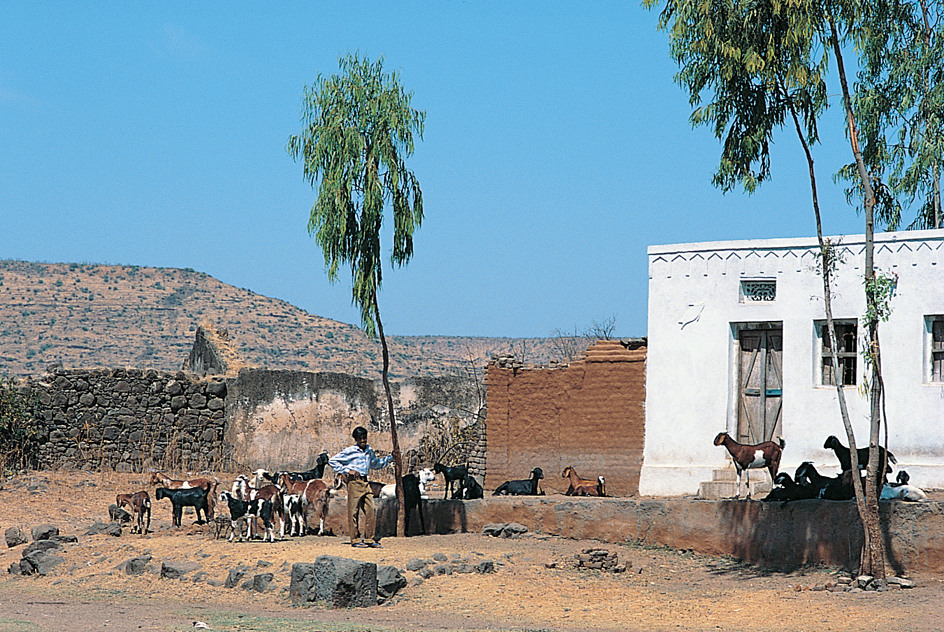
Most villagers own few possessions. These belongings typically include brass pots for cooking and clay pots for carrying water and storing grain. Village people cook foods on a chula, a clay oven that burns coal. People sit and sleep on cots of woven string, which are dragged outside on warm days. Many people also sleep outside. If the village is without electric power, kerosene lanterns are used for light. A local well or nearby pond or river provides water for most villages. Some larger villages have running water.
A council of elected elders, called a panchayat, governs most villages. The panchayat has the power to hear complaints and administer punishments.
City life.
Varanasi (also called Banaras or Benares), Patna (formerly called Pataliputra), and some other Indian cities were commercial, political, and religious centers in ancient times. They attracted pilgrims, traders, and people seeking their political fortunes. After arriving in India in the 1600’s, the British developed the fishing villages of Bombay (now Mumbai), Calcutta (now Kolkata), and Madras (now Chennai) into major ports. These cities are now among the largest in India. 

Older Indian cities have a densely populated center. Many of these cities once had walls surrounding them for protection against enemies. After the city expanded outside its walls, the section inside became known as the walled city. Buildings occupy most of the space in city centers, which bustle with activity. People, animals, automobiles, and smaller vehicles, such as rickshaws, hand-pulled carts, and bicycles, compete for space on the narrow, twisting streets. Various traders sell their wares in shops with fronts open to the street. Entire families live in, above, and behind the shops.

During the British rule of India, the Britons who lived in Indian cities made their homes in areas called cantonments. The cantonments had pleasant bungalows and wide, treelined streets, and lay far from the crowded sections where the Indians lived. Today, politicians, military officers, wealthy business people, and other leaders live in the cantonments. These areas now include modern buildings and shopping districts.
Most Indian cities have a growing middle class, which includes government employees, office workers, and shopkeepers. A large number of urban dwellers work at manual labor or in factory jobs. Many vendors, such as vegetable and fruit sellers, cobblers, and plumbers, peddle their goods and services on the street.
The population of Indian cities has increased tremendously since independence. Millions of people have moved from rural to urban areas in search of jobs. This rapid population growth has strained city resources. For example, the supply of water and electric power has not kept up with the needs of the increasing population. Despite efforts to build low-cost and improved housing, many people—including some members of the middle class—still lack adequate homes. As a result, they must live in slums or on the streets. In the slums, as many as 10 people may be crammed into a one-room shack, and toilet facilities may be shared by the entire slum.
Social structure.
Indians, especially Hindus, have traditionally been organized into social groups called castes. A person’s caste determines his or her social status within the community and influences what occupations a person might hold.
Ancient Hindu texts described four main groups called varnas. The Brahmans (priests and scholars) were the highest group, followed by Kshatriyas (rulers and warriors), Vaishyas (merchants and professionals), and Shudras (artisans, laborers, and servants). Over time, each varna came to include smaller castes called jatis. Altogether, the caste system has thousands of categories.
Complicated rules govern contact and behavior between the castes. For example, marriages between people of widely different castes are rare, and the upper castes do not eat with the Shudras. In principle, when members of a caste eat cooked food, it should be prepared only by someone of the same caste or a higher caste. For example, Brahmans would eat only food cooked by other Brahmans. Many members of the upper castes do not eat meat, fish, or eggs.
Today, caste barriers are weaker than they have been in the past, especially in cities. There the various castes mix with one another every day. They work side by side in factories and offices, ride in buses and trains together, and mingle on the streets. In the cities, too, rules against castes dining with one another have greatly relaxed.
A large group of people—approximately 15 percent of the population—is considered to be outside the caste system. Known as untouchables, harijans (children of God), dalits (downtrodden), or the scheduled castes, this group has an even lower status than the Shudras. Untouchables have traditionally held the most undesirable jobs, such as the cleaning of toilets and the disposal of garbage. Some upper-caste people believe that they will be polluted by the touch of members of this group.
Under the Indian Constitution, the untouchables are supposed to have equal rights. Discrimination in jobs and education against the untouchables is forbidden by law. The government has also set aside for them and other disadvantaged groups a significant percentage of government jobs, scholarships, and legislative seats. Nevertheless, the untouchables remain an oppressed group, especially in villages. There, for example, they are often denied entry to Hindu temples and forbidden to draw water from certain village wells. They also may be excluded from participation in village political life.
Religion
plays a vital role in the lives of most Indians. India has no official religion, and people of various faiths practice their religion freely. About 80 percent of the people are Hindus. About 14 percent are Muslims. Smaller percentages of Indians practice other religions. They include Buddhists, Christians, Jains, and Sikhs.
Hinduism.
The religious beliefs and practices of Hindus vary enormously. Hindus have many sacred texts, including the Vedas, the Upanishads, and the Puranas. These writings serve as a guide to moral conduct. 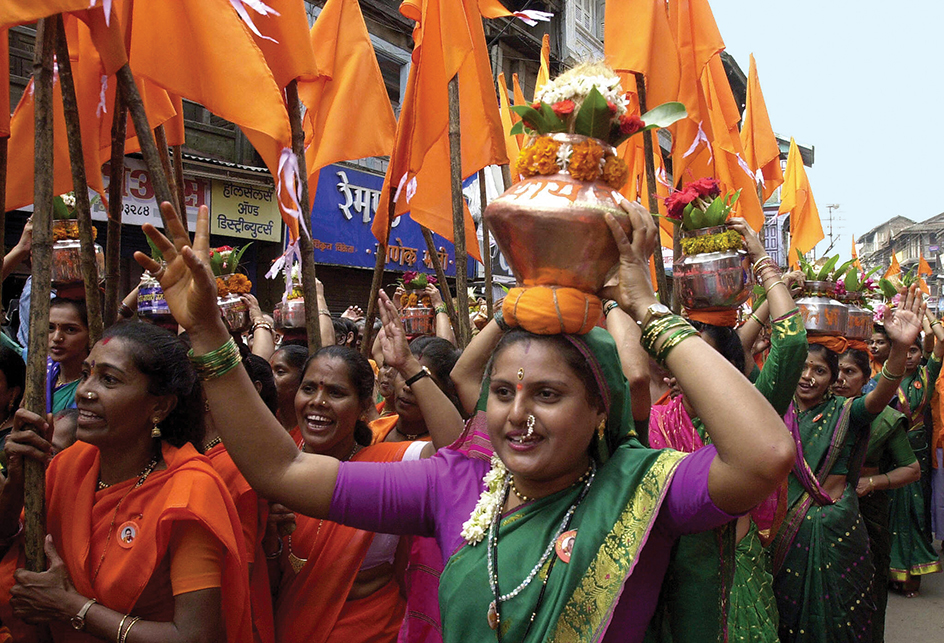
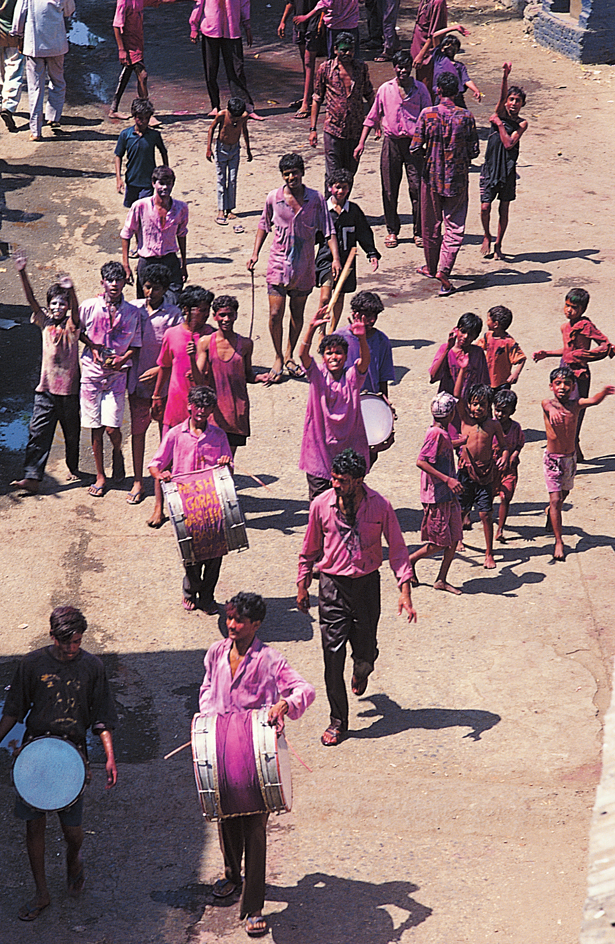
Hindus believe in reincarnation—that is, that the body alone dies, and the soul, which does not die, is reborn in another body. This process can be repeated for thousands of years. Liberated beings are those whose souls, having achieved spiritual perfection, enter a higher state of existence. Hinduism also teaches such virtues as ahimsa (nonviolence), yoga (a spiritual discipline that involves fitness of body and mind), and the unimportance of material goods. Hindus consider cows to be sacred and therefore do not believe in eating beef.
Hindus believe there is a single spiritual force—God, also called Brahman—that takes many forms. These forms make up the many gods and goddesses of Hindu belief. People worship whichever form—that is, whichever god or goddess—pleases them the most. Most Hindus worship Shiva or Vishnu. Vishnu’s two most popular incarnations (human forms) are Krishna and Rama. Popularity of the individual gods and goddesses varies from place to place. In Bengal, for example, worship of the goddess Kali is common, but in Maharashtra, people worship Ganesha (also spelled Ganesa or Ganesh).
There are a number of Hindu religious festivals. They include Holi, which marks the arrival of spring, and a festival popularly called Diwali, which is celebrated in the fall. During Holi, people sprinkle colored water and powders on one another. Fireworks light up the night during Diwali, which honors several Hindu deities.
Islam.
India has one of the largest Muslim populations in the world. Most Indian Muslims live in the north, but there are also major Islamic centers, such as Hyderabad, in the south. Many Muslims live in urban areas.
Islam came to India in the 700’s, but most Muslims in India are descendants of Hindus who converted to the new faith. There have been outbreaks of violence between Muslims and Hindus through the years. But they have also lived together peacefully. Over time, they have developed a common culture in some areas.
Buddhism
was founded in India about 500 B.C. by Siddhartha Gautama. It flourished in ancient India. It later spread to other countries but declined in India. Today, Buddhists are mainly converts from the lower castes.
Christianity
existed in several small communities when Europeans came to India about 1500. But it spread mainly after the Europeans arrived. Indian Christians live largely in the southern states of Kerala and Tamil Nadu, and in the tribal regions of northeast India.
Jainism
was founded in India. Its main organizer was the religious reformer Mahavira, who was born in the 500’s B.C. Jains believe all life is sacred, and most are strict vegetarians. They have been especially successful in business and the professions. 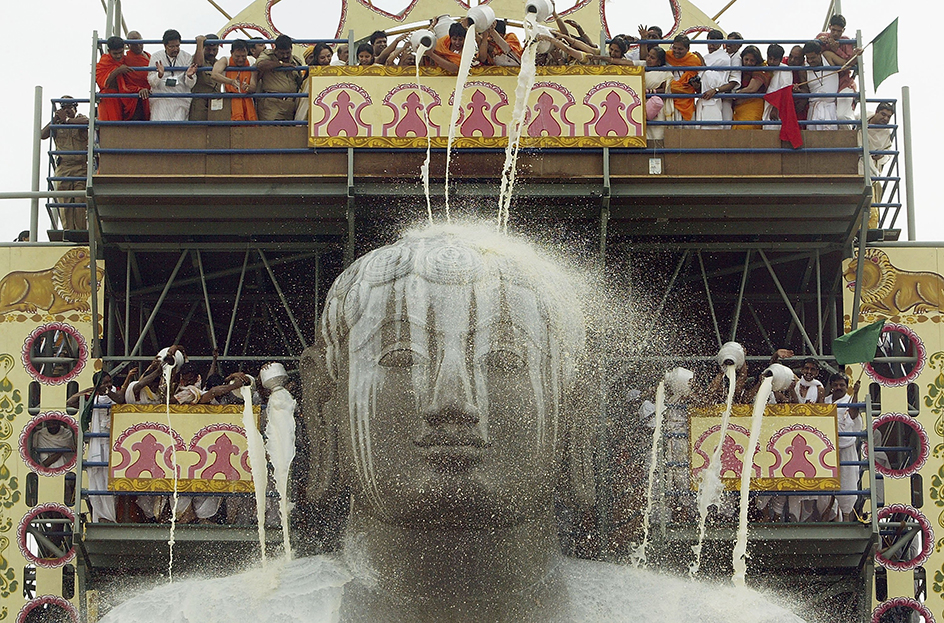
Sikhism
is a religion founded in India by Nanak, a guru (religious teacher) who lived in the late 1400’s and early 1500’s. Sikhs pride themselves on their bravery and do not believe in caste. As a mark of equality, many Sikh men use the same last name, Singh, which means lion. Most Sikhs are farmers and traders. They also make up a large part of the Indian army.
Other religions.
India also has the largest population of Zoroastrians in the world. Usually called Parsis in India, the Zoroastrians fled Persia (now Iran) over 1,000 years ago when it was being converted to Islam. They have become business leaders. India has had a Jewish community since about the A.D. 100’s, though many Indian Jews moved to Israel during the 1950’s and 1960’s. Many Indians also practice folk religions.
Clothing
worn by Indians varies greatly by region. Members of the various religious or ethnic groups also may dress differently. But most Indians wear light, loose clothing because of the hot climate.
Most Indian women wear a sari. This garment consists of a straight piece of cloth about 6 yards (5.5 meters) long that is draped around the body as a long dress. Its loose end is flung over a shoulder or used to cover the head. A sari is usually worn with a blouse. Unmarried women and young girls, especially in northern India, commonly wear long flowing trousers called a shalwar and a long blouse known as a kameez. Tribal women wear long skirts. Many Christian women in the south wear Western-style skirts and blouses. Some young women in cities, especially wealthier women, wear jeans.
Many men wear a dhoti. This simple garment, which is usually white, is wrapped between the legs to form a kind of loose trousers. It can also be wrapped around the lower half of the body like a skirt and is then knotted at the waist. A shirt is worn over the upper half of the body. Poor laborers and farmers may wear only a loincloth, which is a piece of cloth wrapped around the hips and between the thighs. On formal occasions, some men wear a long, tight coat over loose trousers called a pajama that are wide at the top and sharply taper toward the bottom. In the cities, Western-style shirts and trousers, and increasingly, jeans, are popular.
Food and drink.
Rice, wheat, and other grains rank among the chief foods of India. Pulses, which are the seeds of such pod vegetables as beans, chickpeas, and lentils, are also widely consumed.
Indian cooking is extremely varied, and foods eaten in one part of the country may be completely unknown elsewhere. For example, a typical north Indian meal consists of chapattis, dal, and a vegetable dish. Chapattis are thin, flat breads. Dal is a porridge made with specially prepared lentils. A typical meal in West Bengal would probably also include fish, and rice would substitute for the chapattis. In the south, a typical meal would consist of rice, sambar (a lentil preparation that resembles dal), and vegetables. Yogurt, pickles, and such fresh fruits as apples, bananas, guavas, and mangoes are part of most meals throughout the country. 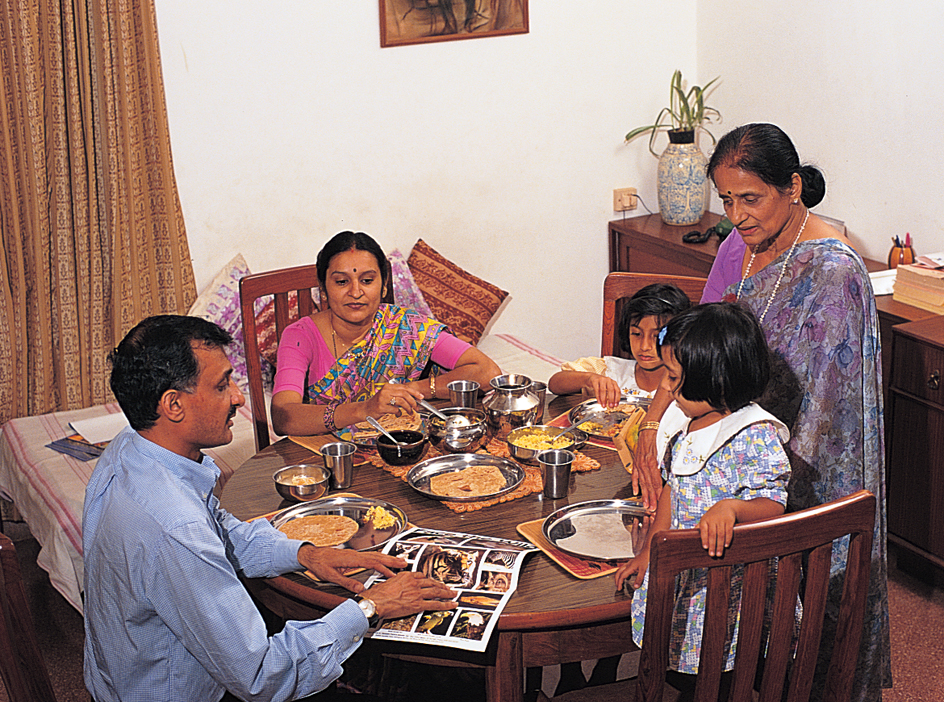
Most Indian meals are cooked in ghee (liquid butter) or vegetable oil. A number of spices, such as coriander, cumin, garlic, ginger, mustard seeds, red pepper, and turmeric, flavor most dishes. Chicken and mutton are expensive and are eaten mainly on special occasions. Hindus do not believe in eating beef, and Muslims do not believe in eating pork. Many Indians are vegetarians.
The most popular beverage in India is tea, though many southern Indians prefer coffee. Western soft drinks are widely available, but fairly expensive.
Food production in India increased enormously in the late 1900’s, and today the country exports wheat and rice. Even so, the nutritional needs of at least a third of the population are not being met, in part because many people cannot afford sufficient food. Many women, in particular, have trouble getting adequate nourishment. Especially in traditional homes, the men and children are served by the women and older girls, who eat what is left at the end of the meal.
Health care.
Life expectancy rates for both women and men are much lower in India than in the United States and Europe. Infant death rates are much higher. See Life expectancy (table: Life expectancy at birth for selected countries).
Dismal living conditions account for many diseases. Standards of sanitation, hygiene, and nutrition are poor, especially in villages and urban slums. High levels of pollution in the cities have led to a sharp increase in illnesses of the lungs.
On the other hand, India has made great strides in controlling cholera, malaria, and other infectious diseases. Government clinics across the country provide cheap medical care to government employees and their families. Other public clinics and hospitals attend to the needy. In addition, the government runs family-planning clinics to help control the growing population. In urban areas, thousands of doctors have set up private practices, often at their own homes. 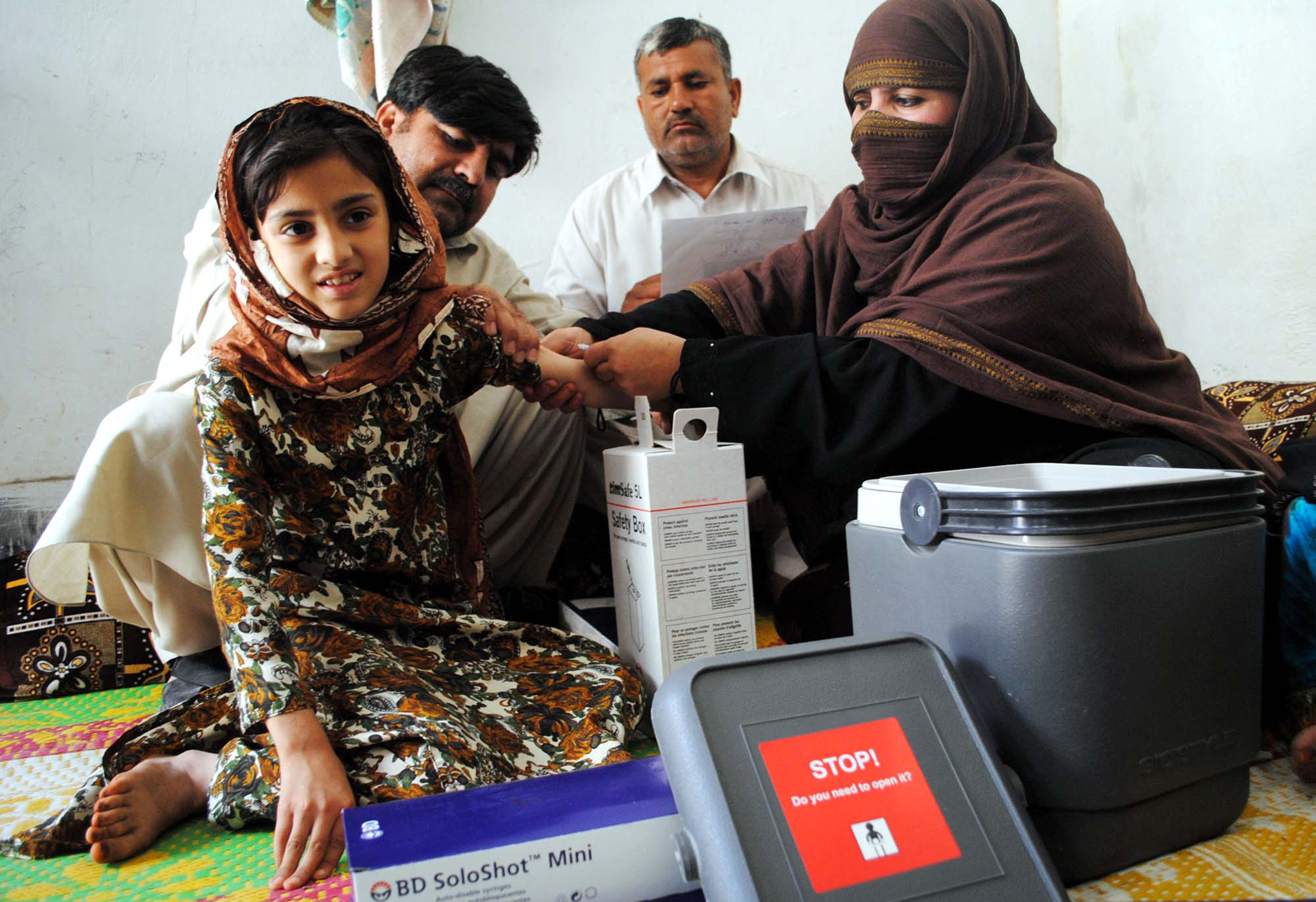
Recreation.
The favorite sport in India is cricket. Field hockey and soccer are also popular. Indians enjoy playing cards and chess. Kite flying is also a common recreational activity. Many people spend their evenings watching television or going to motion-picture theaters. In large cities, people also attend concerts and plays.
Education.
The Indian Constitution provides for free education for children from age 6 through 14. Nearly all Indian children receive some schooling, but only about half of those 10 years of age or older continue their education. There are several reasons why children drop out of school. Some children leave school because their parents put them to work on the family farm. Other children have to get jobs to help support their families or are needed at home to look after smaller children. 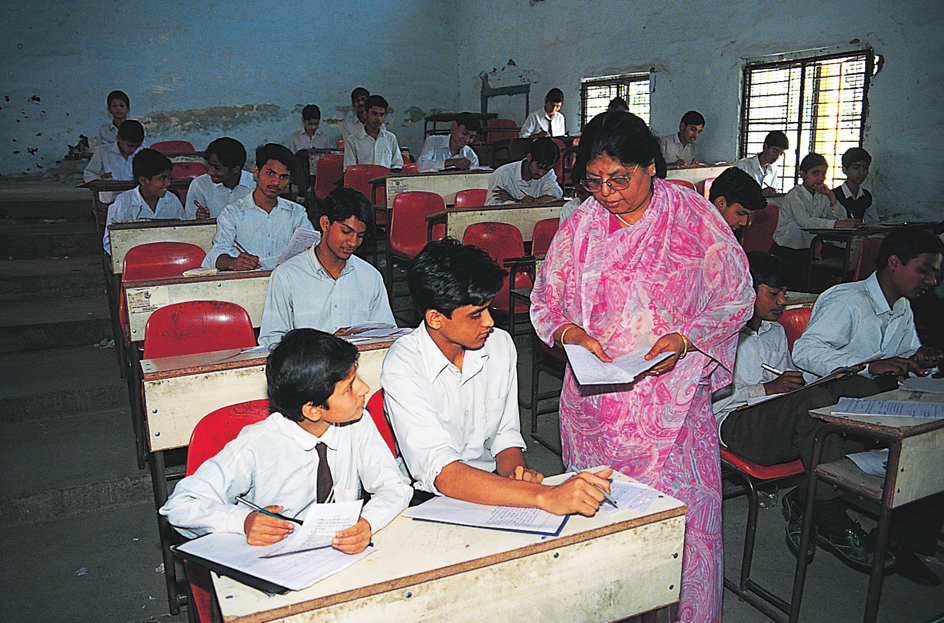
Because Indians receive little formal education, illiteracy is a major problem in India. Since about 1950, the government has spent much money on training teachers, publishing schoolbooks, and building schools. As a result, literacy rates have improved, and school attendance has increased substantially. However, about two-fifths of India’s adult population still cannot read and write.
Universities are run by the central or state governments. India has thousands of universities and colleges. The University of Delhi is one of the largest.
The arts
The arts of India have a long history. They had reached high levels thousands of years ago. Indian arts also include a wide variety of forms and styles.
Architecture and sculpture.
Sculpture flourished during the Indus Valley civilization, which was established about 2600 B.C. Buddhism was the next great influence on Indian architecture and sculpture. Several ruins of Buddhist monasteries and dome-shaped stupas (monuments) have survived from ancient times. 
Caves were cut into a cliff of solid rock at Ajanta in western India between the 100’s B.C. and the A.D. 600’s. They feature spectacular examples of frescoes (wallpaintings on plaster) and sculpture. Artists worked at the nearby caves at Ellora until about A.D. 1000. The greatest monument at Ellora, dating from the late 700’s, honors the Hindu god Shiva. It was carved out of the cliff like a great piece of sculpture. Magnificent sculptures of Hindu gods and goddesses were also carved in the caves at Elephanta, near Mumbai, mainly from the 600’s to 900’s.
Hindu temples are noted both for their architecture and for their exquisite sculptures. The temples have rows of sculptured columns, richly carved exteriors, and open porches. Temples in northern India have tall towers with curving sides that taper at the top. South Indian temples have gateway towers shaped like trapezoidal pyramids and made of steplike layers of stone. Each step has carvings that tell a story.
Muslims conquered parts of northern India during the 1200’s and introduced their style of architecture. Muslim architecture in India reached its peak in the 1500’s and 1600’s. The outstanding Islamic building in India is the Taj Mahal (about 1650) in Agra. The Emperor Shah Jahan ordered the Taj Mahal built as a tomb for his favorite wife. The building features magnificent Islamic-style decoration, in which geometrical patterns and floral designs are inlaid in marble with semiprecious stones. Islamic art and architecture use such patterns and designs because Islam forbids the depiction of God or the human form. 
The British and other Europeans added many buildings in Western styles to India after their arrival. During the 1700’s, the British constructed churches and other buildings in the neoclassical style. Neoclassical architecture reflected a renewed interest in Europe in the architecture of ancient Greece and Rome. In the 1800’s, the British designed many public buildings in India in the Gothic Revival style, with tall spires and pointed arches. Some British buildings include curved domes and other features of Islamic architecture.
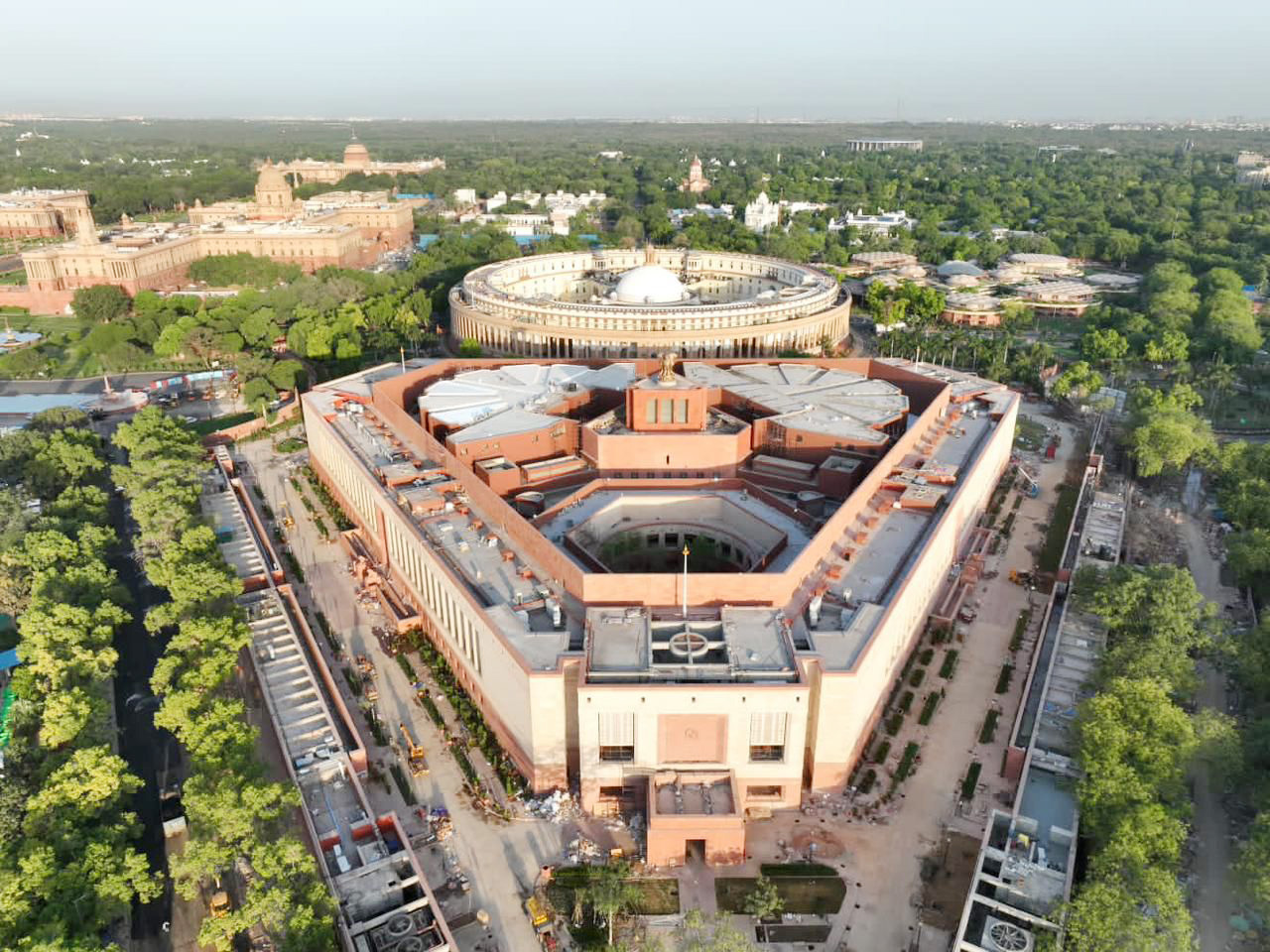
Modern Indian architecture borrows from many styles. For example, the internationally recognized works of Charles Correa and Balkrishna Doshi mix traditional Indian forms with contemporary designs.
Painting.
The frescoes in the caves at Ajanta are the most important early examples of Indian paintings. Wallpaintings that show scenes from Buddhist stories are commonly found in Buddhist temples and monasteries.
Miniature paintings on small pieces of paper developed into a distinct art form in India from 1500 to 1800. These paintings portrayed rulers, members of the nobility, scenes of hunting, or stories from Hindu legends. 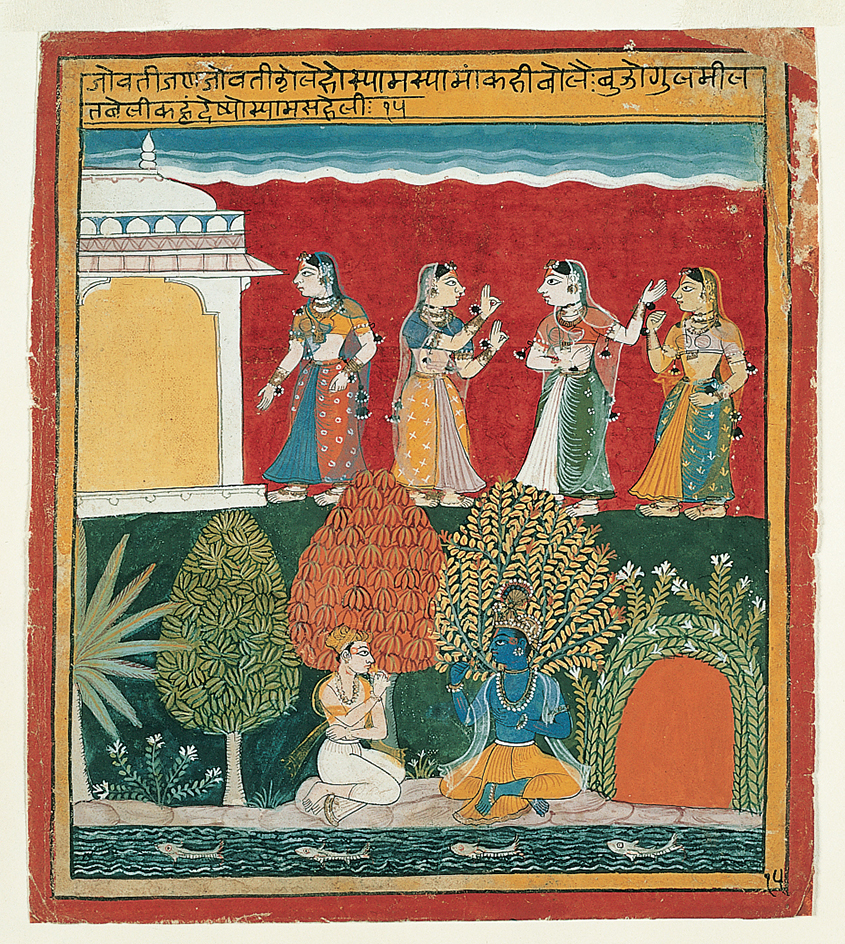
In the 1800’s, Indian painting was mainly an imitation of Western styles. Many artists of the 1900’s, including Maqbool F. Husain and Amrita Sher-Gil, show both Indian and Western influences. Husain’s paintings resemble those of the European expressionists, who attempted to give form to powerful emotions. Sher-Gil studied art in France but painted mostly Indian subjects. Nandlal Bose’s works are based mainly on Indian folk forms.
Literature.
All of India’s major languages have written literatures, many of which are at least 1,000 years old. The earliest Indian written works—the Vedas—are about 3,000 years old. Composed in an early form of Sanskrit, these Hindu scriptures are poetical compositions that discuss God, the universe, and the nature of life.
India’s two great epics, the Mahabharata and Ramayana, were also composed in Sanskrit. Parts of the Mahabharata, which includes the Bhagavad-Gita, are probably more than 2,500 years old. The Ramayana was likely begun about the same time. These poems have inspired Indian literature through the centuries. Today, they are generally read not in Sanskrit but in other Indian languages and English.
Many of the world’s fables and folk tales come from India. The oldest collection of fables in India, the Panchatantra, may date from as early as the 200’s B.C.
From about A.D. 500 to 1600, a social and religious movement called bhakti swept across India. Bhakti influenced the development of regional languages because it emphasized people’s everyday speech. Many bhakti poets, including Jnanadeva, Kabir, Mira Bai, Surdas, and Tulsidas, are still among the most widely read authors in India. Their hymns are also set to music.
Later Indian literature continued to be written in all the major Indian languages and English. For example, Bankim Chandra Chatterji, sometimes called the father of the Indian novel, wrote in Bengali. His historical novels about Indian heroes helped spread Indian nationalism in the 1800’s. Bengali-language writers of the early 1900’s include Rabindranath Tagore, whose spiritual poetry won the Nobel Prize in literature in 1913, and Saratchandra Chatterji (also spelled Saratcandra Chattopadhyaya), whose novels emphasize social issues. Several well-known Indian-born writers in the late 1900’s wrote in English. These included R. K. Narayan, whose novels depict Indian village life, and Salman Rushdie, whose writings combine fantasy, satire, and Hindu and Islamic lore.
Music and dance.
The beginnings of Indian classical music date to ancient times. Styles, forms, and principles of composition developed over the centuries. Indian music sounds different from Western music partly because it uses different scales and musical instruments. The notes of the Indian scale are arranged in various patterns called ragas. Each raga has a special meaning and may be associated with a particular mood, emotion, season, or time of day. Indian instruments include the sitar, sarod, and vina, which are plucked stringed instruments; the tambura, which produces a drone (continuous tone); and the tabla and mridangam, which are drums. 
Indian folk song
Music for motion pictures, called film music, is extremely popular in India. Film music combines Indian classical, folk, and religious music with certain features of Western music. Film music, for example, is typically played by a large orchestra that includes both Indian and Western instruments.
There are several major styles of classical Indian dance. They include the bharata natyam of southern India and the kathak of northern India. Both of these styles, like all classical Indian dances, draw upon the Hindu epics and other poems and stories about the lives of the Hindu deities. Both styles of dancing use highly stylized hand, foot, and arm gestures, and movements of the eyes and other facial features to indicate moods and tell stories.
Folk dancing is also popular and varies from region to region. For example, a favorite folk dance in the Punjab is the lively bhangra, in which male dancers jump high in the air. Like other folk dances, the bhangra has a freer form than classical dances.
Motion pictures.
India’s motion-picture industry produces thousands of films annually. The industry, centered in Mumbai, is known as Bollywood. Indian movies are made in many languages, often for regional audiences. The most popular motion pictures are those made in Hindi, which are shown throughout the country. Hindi films also attract audiences in the Middle East, North and East Africa, the Caribbean, and Indian communities overseas. 
Indian popular films include love stories, crime thrillers, and social dramas. Like American musicals of the 1930’s, many Indian popular films feature song-and-dance sequences.
The Indian motion-picture industry is also known for its art films. These motion pictures are more realistic than popular films. They explore such serious social themes as the problems of life in the city, the oppressiveness of the caste system, the difficulty of human relations, and the nature of guilt.
Several Indian directors have won international recognition for their work. Satyajit Ray won particular praise for his Apu trilogy, a series of three motion pictures describing the growth of a boy to manhood in modern India. Other directors noted for making realistic films about Indian life include Shyam Benegal, Ritwik Ghatak, Adoor Gopalakrishnan, Mira Nair, and Mrinal Sen. Ismail Merchant, an Indian film producer, won international acclaim for his film adaptations of literary works.
The land
Tall mountains separate most of northern India from the rest of Asia. The southern half of the country is a triangular peninsula that juts into the Indian Ocean. The Arabian Sea laps India’s shores to the west, and the Bay of Bengal lies to the east.
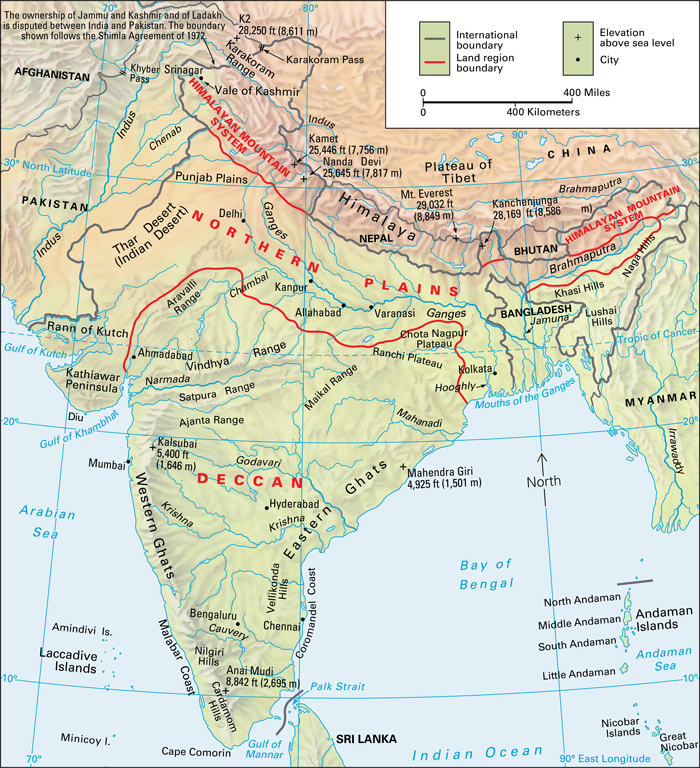
India has three main land regions. They are (1) the Himalaya, (2) the Northern Plains, and (3) the Deccan, also called the Southern Plateau.
The Himalaya,
the highest mountain system in the world, extends for about 1,500 miles (2,400 kilometers) from northernmost India to the northeastern part of the country. The three almost parallel ranges of the Himalaya in India are nearly 200 miles (320 kilometers) wide at some places. The tallest mountain in India, Kanchenjunga, stands 28,169 feet (8,586 meters) high on the border of Nepal and India in the Himalaya. Dozens of other peaks in the system are more than 20,000 feet (6,100 meters) high. Snow covers the tall peaks throughout the year. The foothills of the Himalaya have many kinds of wildlife, including tigers, deer, and rhinoceroses, and many wildflowers. 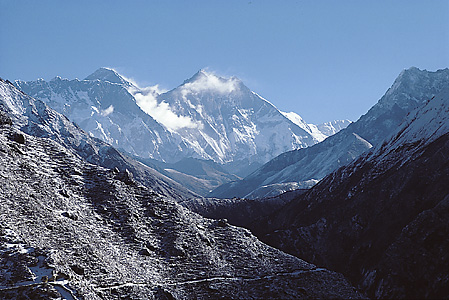
The Northern Plains
lie between the Himalaya and the southern peninsula. They stretch across northern India for about 1,500 miles (2,400 kilometers) and are from 150 to 200 miles (240 to 320 kilometers) wide. The plains include the valleys carved by the Brahmaputra, Indus, and Ganges rivers and their branches. This region is the great heartland of India and forms the largest alluvial plain in the world. An alluvial plain is land formed of soil left by rivers. The soil in the Northern Plains is fertile, and farmers have tilled the land for centuries. The majority of Indians live in this region.
The Ganges, also known as the Ganga, is the greatest river in India. It originates high in the Himalaya and flows into the Bay of Bengal. Many important towns and cities, including Allahabad and Varanasi, lie along its banks. The Ganges is sacred to Hindus, and many Hindus bathe in the river to cleanse and purify themselves. 
The Thar Desert (also called the Great Indian Desert or the Indian Desert) lies in the western part of the Northern Plains. It covers much of the state of Rajasthan and parts of Gujarat. Few people live in this area.
The Deccan Plateau
forms most of the southern peninsula. It is separated from the Northern Plains by a mass of mountain and hill ranges, most prominently the Satpura, Vindhya, and Aravalli. On the eastern edge of the Deccan, a rugged mountain range called the Eastern Ghats rises to an average height of 2,000 feet (610 meters) before slanting down gradually to a wide plain. The Western Ghats form the western boundary of the Deccan. This range reaches a height of about 8,000 feet (2,440 meters) before falling sharply to a narrow coastal plain. The southernmost point of the plateau is formed by the Nilgiri Hills, where the Eastern and Western Ghats meet. 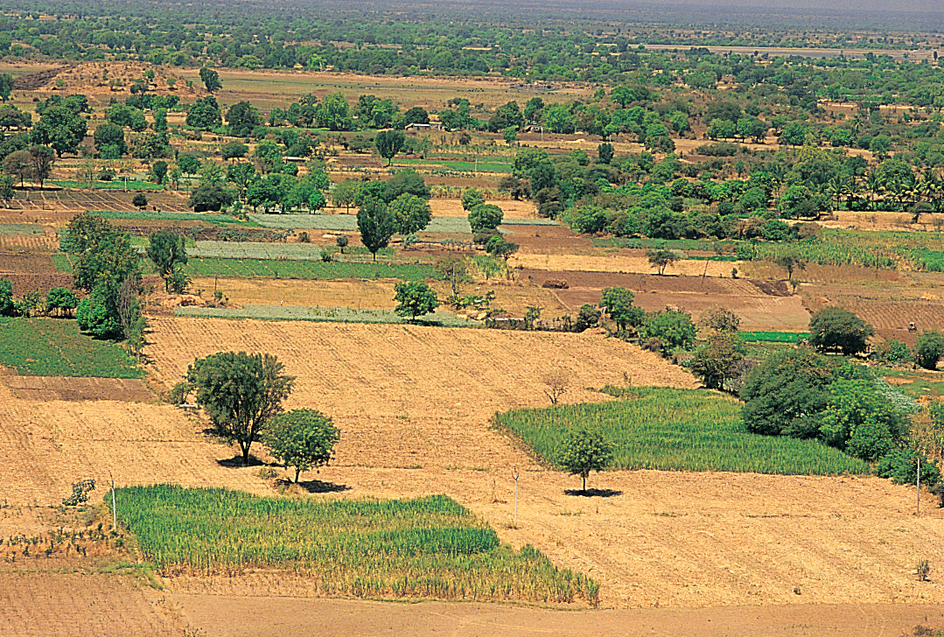
Major rivers of the Deccan Plateau include the Cauvery (also spelled Kaveri), Godavari, Krishna, and Mahanadi. Most of the Deccan is farmland. Parts of the Eastern and Western Ghats are heavily forested and are home to elephants, monkeys, and other wildlife.
Climate
Most of India has three main seasons. They are (1) the cool season, (2) the hot season, and (3) the rainy season.
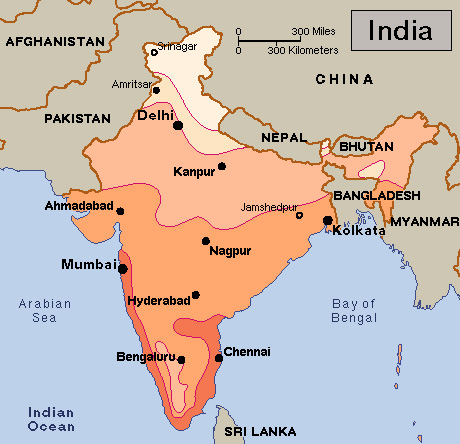
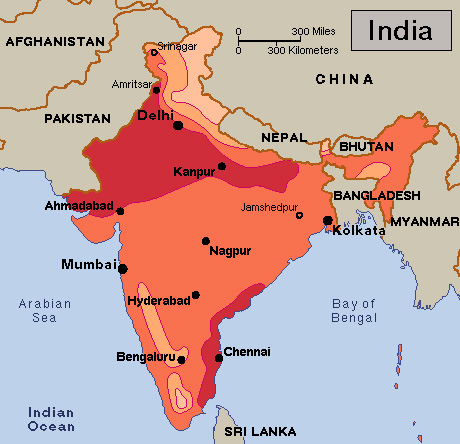
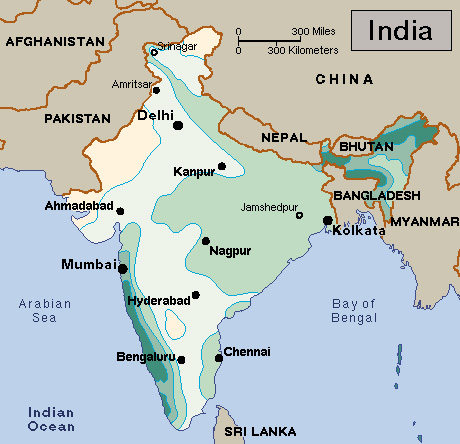
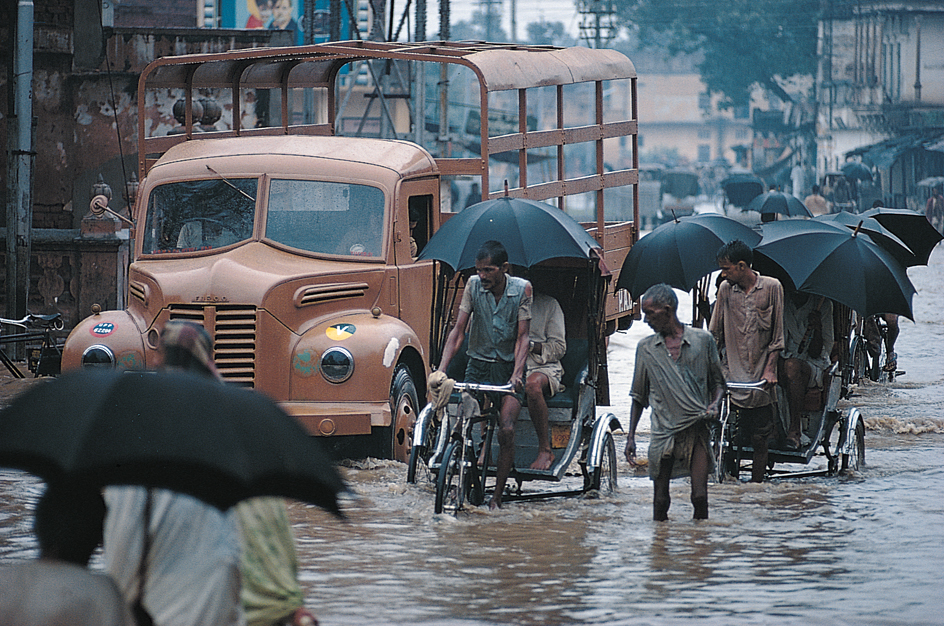
The cool season
lasts from October to February. During the cool season, the foothills of the Himalaya receive much snow, though the highest peaks are snow-covered the year around. During the cool season, the temperature in the Himalaya region drops well below the freezing point of 32 °F (0 °C). The northwestern and north-central parts of the Northern Plains have a wide range of daily temperatures during the cool season. Days are warm, but temperatures sometimes drop below freezing at night. In the eastern part of the Northern Plains and in the Deccan, the temperature never reaches freezing.
The hot season
lasts from March to June, though the Northern Plains and the Deccan are hot for much of the year. In the hot season, temperatures in the plains routinely go up to 115 °F (45 °C). Temperatures often rise to 123 °F (49 °C) in the desert region. Temperatures on the coastal plain average 85 to 90 °F (29 to 32 °C). In the Deccan, daytime temperatures in the hot months generally average from 90 to 100 °F (32 to 38 °C).
The rainy season
can last from June to September. However, India usually receives rain from five to seven weeks during this period. During the rainy season, seasonal winds called monsoons blow across the Indian Ocean and pick up moisture on the way. The monsoons, which strike from the southeast or the southwest, bring heavy downpours. Although there is some rain at other times of the year, most of India receives its rain through the monsoons.
There is much Indian lore about the monsoons, which provide relief after months of scorching heat. The monsoons also are of great importance to India’s agricultural production and the health of the economy. If the monsoons bring enough rain to the country, crops will grow. Sometimes the rains fail to arrive on time, and crops are poor as a result. Some monsoons drop too much rain and cause rivers to overflow, crops to be ruined, villages to be washed away, and many lives to be lost.
Rain falls most heavily in northeastern India. Some hills and mountain slopes in this region receive an average of about 450 inches (1,140 centimeters) of rain a year. The world’s heaviest recorded rainfall for a one-year period fell at Cherrapunji. This village had almost 1,042 inches (2,647 centimeters) of rain from August 1860 to July 1861. The Thar Desert in the northwestern part of the country receives less than 10 inches (25 centimeters) of rain a year. Some sections of the desert get less than 4 inches (10 centimeters) of rain annually.
Economy
India has one of the largest economies in the world in terms of its gross domestic product (GDP). Gross domestic product is the value of all goods and services produced in a country in a year. However, India has such a large population that the country has an extremely low per capita GDP. This figure is determined by dividing a nation’s GDP by its population. As a result of its low per capita GDP, India is considered a developing country and one of the poorest countries in the world.
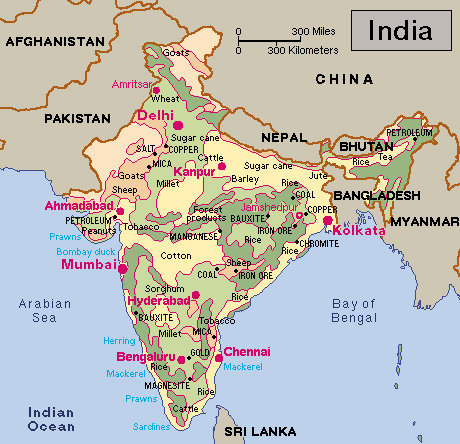
Until 1991, the Indian government firmly controlled the economy. It owned all major industries. It also placed heavy duties (taxes) on the import of goods from other countries and allowed foreign companies to invest and trade only under strict supervision. Since 1991, however, India has moved closer to a free enterprise system. The government has encouraged foreign investment and corporate ownership, ended many government monopolies, and greatly reduced duties on goods imported from other countries.
Agriculture
provides the main source of income for about half of the population. Farms cover over half the country’s land. Most of the farmland is used to grow India’s major grains and pulses (beans, lentils, and seeds). The major grains include corn, millet, rice, sorghum, and wheat. Rice leads all crops in land area. India is the world’s leading producer of millet, and one of the leading producers of corn and sorghum. Only China produces more rice and wheat than India. 

India is also the world’s leading producer of bananas, a fiber called jute, and mangoes. It is a major grower of cabbages, cauliflower, coconuts, coffee, cotton, onions, oranges, potatoes, rapeseed, rubber, sesame seeds, sugar cane, tea, tobacco, and tomatoes. Cardamom, ginger, pepper, turmeric, and other spices are also important products.
In the past, India imported much of its food. Today, however, it is more self-sufficient in food production. India’s increase in agricultural production came about partly because of the Green Revolution, the introduction of high-yielding seeds in the 1960’s. Improved farming techniques, greater mechanization, and irrigation have also increased agricultural production. In addition, farmers are paid high prices for their crops to encourage them to grow more, and many rural development programs make credit and machinery easily available.
Large farms, such as those in the Punjab, which is called India’s “breadbasket,” grow food for sale. However, most Indian farmers are subsistence farmers, who grow crops mainly to feed their families, not for commercial purposes. Most of India’s farmers own the land on which they work.
Most Indian farms are small. This is due in part to inheritance customs. After a farmer dies, his farm is divided among his sons. After these sons die, the land is further divided among their sons. With each generation, the size of the farm decreases, and it may become too small to provide a living.
India is one of the world’s leading cattle-raising countries. The animals serve a variety of purposes. In most of rural India, farmers still use oxen to plow the land. Dairy farming is important. Milk from water buffaloes is also sold commercially. The hides of cattle and water buffaloes are used to produce leather and leather goods. There is almost no beef farming in India, because Hindus are not supposed to eat beef.
Manufacturing.
India is one of the world’s top producers of iron and steel. Huge iron and steel mills are in Bhilai, Bokaro, Jamshedpur, Rourkela, and Vishakhapatnam. Indian factories use the iron and steel to manufacture such products as aircraft, automobiles, bicycles, electrical appliances, machinery, military equipment, railway cars, sewing machines, and tractors. Factories also produce cement, computers, fertilizer, food products, industrial chemicals, petroleum products, and pharmaceuticals (medicinal drugs). One of India’s largest employers is the textile industry. Cotton mills are in western India, especially near Ahmadabad and Mumbai, and in southern India.
Millions of Indians work at home or in small plants. Some of these workers produce cotton textiles on hand looms. Others manufacture matches, incense sticks, and a variety of handicrafts, including brassware, embroidered textiles, jewelry, leather goods, and woodcarvings. Although craft goods are made throughout the country, individual regions tend to specialize in certain ones. For example, Kashmir is famous for carpets, South India for brass, and Rajasthan for puppets.
Mining.
India has valuable deposits of a variety of natural resources. The country is one of the world’s leading producers of iron ore. Iron ore deposits lie mainly in Chhattisgarh and Odisha (formerly Orissa). Coal, natural gas, and petroleum account for about two-thirds of the yearly value of all minerals mined in India. India is one of the world’s largest coal producers. Huge coal deposits lie in Chhattisgarh, Jharkhand, Madhya Pradesh, Odisha, and the western end of West Bengal. There are some inland deposits of petroleum, mainly in Assam and Gujarat, but most drilling is off the shore of Mumbai. The country also mines bauxite, chromite, copper, gypsum, limestone, magnesite, mica, sulfur, titanium, and zinc. India also has supplies of two radioactive metals, thorium and uranium. India has deposits of a number of precious metals and stones, including diamonds, emeralds, gold, and silver. Cut diamonds are one of India’s biggest exports.
Forestry and fishing.
Forests cover only about 20 percent of India’s land area. Starting in the mid-1900’s, the country’s forestland shrunk rapidly as more trees were cut down than were planted. However, conservation movements are now working to restore Indian forests. In most cases, the previous forests, which had a variety of trees, are being replaced by fast-growing eucalyptus or pine trees. Villagers cut down trees for use as fuel. Deodar cedar, rosewood, sal, and teak trees are cut for timber.
Fishing is a way of life for millions of people who live on India’s coasts, and it is one of the chief industries in such coastal states as Andhra Pradesh, Kerala, Odisha, Tamil Nadu, and West Bengal. The main varieties of fish caught from the seas around India include Bombay duck, croakers, mackerel, prawn, and sardines. Aquaculture, the commercial raising of animals and plants that live in water, is a growing industry in India. Carp is the most valuable aquaculture product.
Service industries
are economic activities that provide services, rather than produce goods. Service industries account for about one-half of India’s GDP, and about one-third of its employment. A growing urban population and increasing commercial and communication links between India and the rest of the world have led to a dramatic expansion of the country’s service industries. Trade, restaurants, and hotels is one of India’s leading service industry group. This group greatly benefits from the millions of tourists who visit India each year. Many of these visitors come from Bangladesh, the United Kingdom, and the United States.
India’s major stock exchange is in Mumbai, which is the nation’s business, finance, and trading capital. Kolkata ranks as the world leader in the wholesale trade of jute. Bengaluru is the center of the country’s computer industry. Many multinational companies have customer-service call centers in India.
Energy supply.
India has rich deposits of coal, and petroleum production is increasing. Nevertheless, India still imports large amounts of petroleum because it uses more than it produces. India must also import natural gas. Plants that burn coal or natural gas generate about 70 percent of India’s electric power. Much of the rest comes from hydroelectric plants. Nuclear power plants generate a small percentage of India’s electric energy.
International trade.
The value of India’s imports is greater than the value of its exports. The main import is petroleum, which comes from the Middle East. Other imports include chemicals, copper, diamonds, gold, iron and steel, and machinery. India exports chemicals, cotton textiles and clothing, cut diamonds and jewelry, iron ore, machinery, petroleum products, and transportation equipment. India’s main trading partners include China, Germany, Japan, Saudi Arabia, Singapore, Switzerland, the United Arab Emirates, and the United States.
Transportation.
India’s railway system is one of the world’s largest. It is also the single largest employer in the country. Billions of passengers travel by train in India annually. The government keeps the price of train travel low enough for most people to afford it. The railway system was owned and operated by the government for many years. In 2015, India began allowing foreign investment in its railways. 
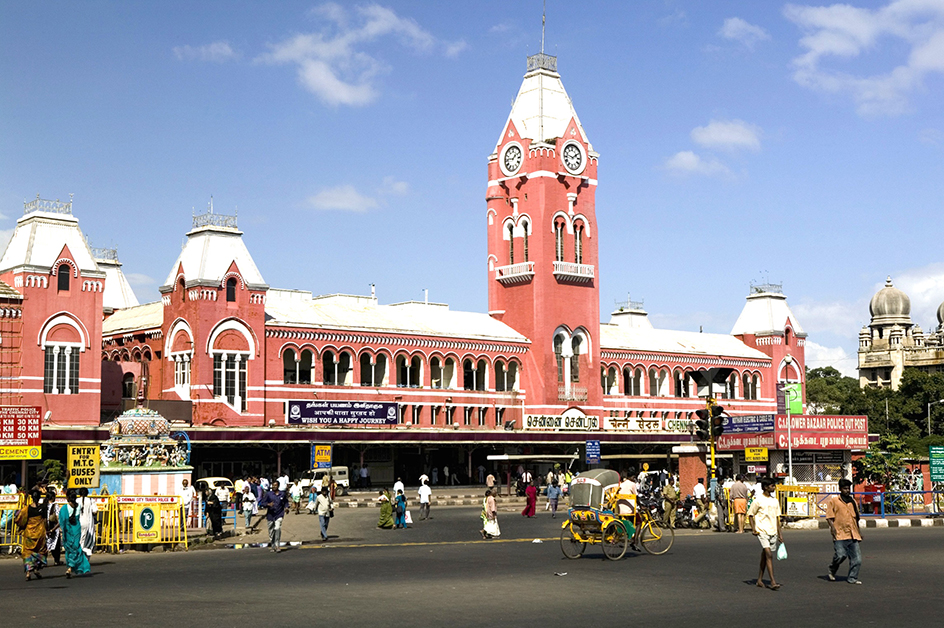
India is well connected by roads, but the roads generally are not well maintained. In urban areas, buses are a popular form of transportation. Automobile and motorcycle ownership is growing rapidly in India. Buses, cars, and motorcycles all share the roads with animal-drawn carts, bicycles, pedestrians, scooters, and trucks.
India has major seaports at Chennai, Kandla, Kolkata, Mumbai, and Vishakhapatnam. The Brahmaputra, Ganges, and other major rivers carry boat traffic.
Several private and government-owned airlines operate within India. These airlines provide both domestic service and international flights. Bengaluru, Chennai, Delhi, Hyderabad, Kolkata, Mumbai, and Trivandrum (also spelled Thiruvananthapuram) have major international airports.
Communication.
Radio and television stations are both privately owned and government-owned. The number of connections to cable and satellite systems is growing rapidly, making more channels and a wider variety of television programs available to many viewers.
India publishes thousands of daily newspapers in English, Hindi, Urdu, and other languages. Leading newspapers include Dainik Jagran, Hindustan Times, Malayala Manorama, and The Times of India.
Telephone services reach throughout India. A rapidly growing number of Indians use cellular telephones. Internet usage has rapidly increased since the early 2010’s.
